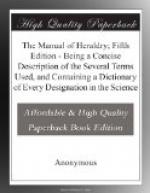PENDANT. A shield suspended or hanging from a branch of a tree, or from a nail. Shields of arms frequently appear drawn thus in architecture, and when described are said to be pendant.
[Illustration: Pennons]
PENNONS. Small flags borne at the end of a lance of an esquire or gentleman bearing his paternal arms. The end of the pennon was cut off upon the person being created a knight banneret. See BANNERET. Penoncels or Pencils were small flags decorating the helmet or the horse armour. They are now only used at funerals. The large flag in the engraving is a pennon, the smaller, penoncels or pencils.
PHEON. A missile instrument with a barbed head, thrown from a cross bow.
[Illustration: Pheon]
Ex. Argent, a pheon proper.
PIERCED OR PERFORATED. Cut through the centre.
[Illustration: Pierced]
Ex. Argent, a mullet pierced, sable, on a chief azure, three mullets pierced, of the first.
PILE. An angular figure like a wedge, formed by lines running from the dexter and sinister chief to the middle base.
[Illustration: Pile]
Ex. Argent, a pile, purpure.
IN PILE. Arms or other charges that are placed so as to form the shape of a pile are said to be borne in pile.
[Illustration: In pile]
Ex. Argent, three swords in pile, their points towards the base.
PLATE. One of the six roundlets; its colour is argent, but the tincture is not mentioned, as the plate is always silver.
POMEIS. Green roundlets.
[Illustration: Pommelled]
POMMELLED. The pommel of the sword is the round ball or knob at the end of the hilt of a sword.
[Illustration: Portcullis]
PORTCULLIS. A grating suspended by chains, used to defend the entrance to a castle.
POTENT. The ancient name of a crutch: when the field is covered with figures like small crutches it is called potent; when the heads of the crutches touch each other it is called counter potent.
[Illustration: Potent and counter potent]
Ex. Argent and azure, potent and counter potent. Some armorists call counter potent vary cuppy.
PRINCE. The only Principality in Great Britain is that of Wales. The title of Prince of Wales is usually conferred upon the eldest son of the British monarch. All other sons, grandsons, brothers, uncles, and nephews, are called princes of the blood royal. For instance, the Duke of Cambridge, the uncle of Queen Victoria, is styled His Royal Highness Prince Adolphus Frederick Duke of Cambridge.
His son is styled Prince George of Cambridge.
PRINCESS. Daughter of a sovereign. In England the eldest daughter of the monarch is called the Princess Royal; the others by their Christian names.
PROCLAMATION. A publication by the authority of the King. Proclamations of peace or war, or other matters of importance, are usually read by one of the heralds. They are addressed to the whole community under their different orders or ranks, viz. Clergy, Nobility, Gentry, Burgesses, and Commons.




